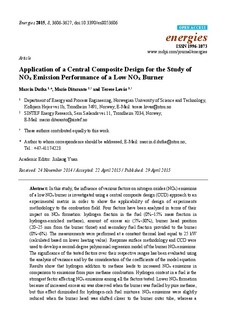Application of a Central Composite Design for the Study of NOx Emission Performance of a Low NOx Burner
Journal article, Peer reviewed
Permanent lenke
http://hdl.handle.net/11250/2364805Utgivelsesdato
2015Metadata
Vis full innførselSamlinger
Sammendrag
In this study, the influence of various factors on nitrogen oxides (NOx) emissions of a low NOx burner is investigated using a central composite design (CCD) approach to an experimental matrix in order to show the applicability of design of experiments methodology to the combustion field. Four factors have been analyzed in terms of their impact on NOx formation: hydrogen fraction in the fuel (0%–15% mass fraction in hydrogen-enriched methane), amount of excess air (5%–30%), burner head position (20–25 mm from the burner throat) and secondary fuel fraction provided to the burner (0%–6%). The measurements were performed at a constant thermal load equal to 25 kW (calculated based on lower heating value). Response surface methodology and CCD were used to develop a second-degree polynomial regression model of the burner NOx emissions. The significance of the tested factors over their respective ranges has been evaluated using the analysis of variance and by the consideration of the coefficients of the model equation. Results show that hydrogen addition to methane leads to increased NOx emissions in comparison to emissions from pure methane combustion. Hydrogen content in a fuel is the strongest factor affecting NOx emissions among all the factors tested. Lower NOx formation because of increased excess air was observed when the burner was fuelled by pure methane, but this effect diminished for hydrogen-rich fuel mixtures. NOx emissions were slightly reduced when the burner head was shifted closer to the burner outer tube, whereas a secondary fuel stream provided to the burner was found to have no impact on NOx emissions over the investigated range of factors.
